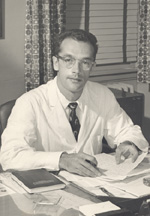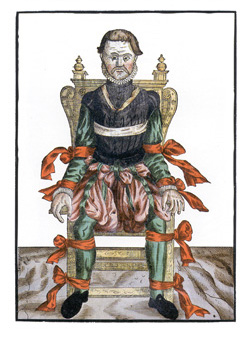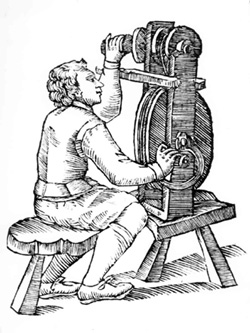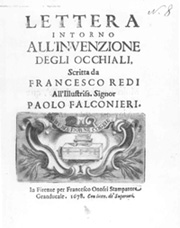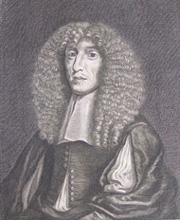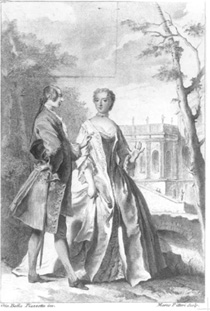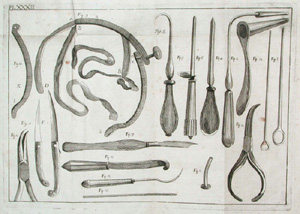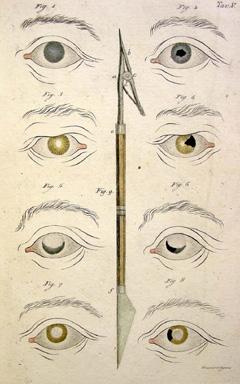The Bernard Becker Collection in
Ophthalmology and Optics
The Bernard Becker Collection in Ophthalmology and Optics is one of North America’s finest rare book and print collections specializing in the sciences of the eye and light; its catalog is an internationally used standard reference source. Bernard Becker (b. 1920) served as chair of the Department of Ophthalmology at Washington University School of Medicine for more than 35 years and during his tenure the department earned national and international renown. His main focus in research was glaucoma and he is coauthor of Becker-Shaffer’s diagnosis and therapy of the glaucomas, which became a classic textbook. Dr. Becker served as editor-in-chief of Investigative Ophthalmology and edited several other journals. He authored more than 500 articles, several of which are landmarks in the development of ophthalmology.
To portray Dr. Becker as a book collector and to describe his excellent ophthalmology and optics collection it is best to quote his own words:
“My love for reading and delight in browsing through libraries and rare book shops have occupied large segments of my free and travel time. A natural consequence of this hobby was the modest purchase of occasional gems that intrigued and interested me. This permitted further study at home in leisure moments. When the acquired items filled all available corners of my study, and even some extra bookcases, I found it necessary to develop an alphabetical list of authors. It never occurred to me, however, that this was more than just personal fun and an exciting hobby.
As the collection grew, I began to feel rather selfish about the possession of these rare and sometimes unique books and developed the need to share the experiences they offered with others. To my surprise I found I have accumulated over 600 volumes! It seemed most appropriate to transfer them to the Medical School Library. I am very grateful to the Medical School for providing me the opportunity to share my hobby and its delights with all who are interested.”
Petrus Lacepiera (d. 1306). Libro de locchio morale et spirituale vulgare. Venice: Joannes Rubeus, 21 May 1496. (Title page illustration) Woodcut.
This incunabulum (an early printed book published before the year 1500) had been translated from Hamman’s 1496 Latin edition. The original Latin text, first published in Augsburg in 1475, was ascribed to Johannnes Peckham, abbot of Canterbury (ca. 1230-1292), as well as to Roger Grosseteste (ca. 1175 - 1253), theologian, logician, and bishop of Lincoln. The real author, however, was Peter of Limoges (i. e., Petrus Lacepiera, d. 1306), physician and astronomer.
Libro de loccio morale, the second earliest printed book on vision, primarily discusses ethical questions, but also contains scientific descriptions of the eye. The treatise deals with the physiology of vision and the properties of light in order to clarify moral issues. Note that the early academic audience includes three women in this late medieval illustration!
Georg Bartisch (1535-1607). Ophthalmodouleia, das ist Augendienst. Dresden: Stöckel, 1583. (Title page)
Georg Bartisch was author of the first comprehensive and in-depth monograph on eye diseases and their various cures. Published in 1583, the Ophthalmodouleia (Augendienst) documents the milestone in the development of medical sciences where ophthalmology became a separate discipline. Though Bartisch could not afford formal education and worked as a surgeon most of his life, his folio volume attests to profound medical knowledge as well as considerable erudition in the humanities — notice the first word of the title in Greek lettering. Bartisch traveled extensively and practiced in various towns of Central Europe. Due to his splendid reputation as an eye specialist, he was appointed oculist to the elector of Saxony in 1588.
Georg Bartisch (1535-1607). Ophthalmodouleia, das ist Augendienst. Dresden: Stöckel, 1583. (Page 143)
This hand-colored woodcut from the Ophthalmodouleia shows an “early form of anesthesia:” a patient in restraints prior to surgery. Written by Georg Bartisch, Ophthalmodouleia is the first comprehensive text on eye diseases, their cures, and especially on eye surgery.
This early work written in the German vernacular and profusely illustrated, gives an insight into sixteenth century medicine as well as into the contemporary way of life. Hairdo, attire, all-over elegance support the authority of the publication.
François de Aguilon. Opticorum libri sex philosophis juxta ac mathemacticis utiles. Antverp: Ex officina Plantiniana, apud Viduam et filios J. Moreti, 1613. (Page 195) Copperplate.
This engraving of putti demonstrating the “horopter” is from Opticorum libri sex (Six Books of Optics) by François de Aguilon. The illustrations throughout the book are by the great Flemish Baroque painter, Peter Paul Rubens (1577-1640).
Opticorum libri sex concerns geometrical optics, which in the Jesuit schools was taught under the heading of Geometry. The book contains a number of original insights and contributions to the field of geometrical optics. Aguilon was the first to use the term “horopter” from the Greek works horos (boundary) and opter (observer). Aguilon pictured the “horopter” as a line on a plane (the backboard of the table) and not as a 3D curve, as modern optics interprets it.
Carlo Antonio Manzini (1599-1677). L’occhiale all’occhio, dioptrica pratica. Bologna: Herede del Benacci, 1660. (Page 158) Woodcut.
Manzini was a renowned Italian astronomer, and the lunar crater Manzinus is named in his honor. In addition to a compendium of stellar positions, he also wrote a scientific treatise on the comet of 1664-65. His best known book, however, is this practical treatise on the design and construction of eyeglasses and telescopes. The work contains one of the earliest detailed accounts about methods of grinding and polishing lenses. The illustration depicting the lens craftsman is a late (17th century) woodcut. Unlike early woodcuts that mostly looked like line and space drawings, this late example of the genre successfully features tones as well — by using parallel lines. The artist’s intent with choosing this simple method might have been to compete in price with the fine shading techniques of the more modern and at the time very popular but expensive copperplate engravings.
Francesco Redi (1626-1698). Lettera intorno all’invenzione degli occhiali. Firenze: F. Onofri, stampatore granducale, 1678. (Title page and frontispiece) Copperplate illustrations.
After taking his degree in medicine, Redi entered the service of the Colonna family at Rome as a tutor, holding the position five years. In 1654 he went to Florence, where he acted as physician to the Grand dukes Ferdinand II and Cosimo III. He was constantly engaged in experiments intended to improve the practice of medicine and surgery. He is most renowned for demonstrating that the presence of maggots in putrefying meat does not result from spontaneous generation but from eggs laid on the meat by flies.
Redi’s writings include a number of scientific documents, e.g. Osservazioni intorno alle vipere, Esperienze intorno alla generazione degl’ insetti, and Consulti medici. In addition, he found leisure for much literary work, was an active member of several of the academies of the time, and he taught in the Studio at Florence in 1666. As a poet, Redi is famous chiefly for his Bacco in Toscana (1685), known as the best example of the dithyramb in Italian.
In this rare scientific letter Redi suggested that the first reference to the invention of eyeglasses can be found in a 1299 manuscript.
Francesco Algarotti (1712-1764). Il Newtonianismo per le dame ovvero dialoghi sopra la luce e i colori. Napoli : s.n., 1737. (Frontispiece) Copperplate.
Newtonianism for the ladies, or dialogues on light and colors was an 18th century best-seller and the first successful popularization of Newtonian physics. Newton’s experiments on the nature of light and colors were described in the form of a genteel dialog between a cavalier and a marchioness. Algarotti, a handsome young Venetian who traveled extensively in Europe, received immediate acceptance from the best intellectual circles. His writings include works on fine art, architecture, and opera.
Guillaume Pellier de Quengsy (1751-1835). Précis ou cours d’opérations sur la chirurgie des yeux. Paris: Dido, le jeune et Mequignon; Montpellier: Rigaut, Roullet, 1789-90. (Plate XXXV) Copperplate.
Pellier de Quengsy’s work is an early comprehensive monograph on the surgery of the eye. Its splendid copperplate illustrations show mostly the instrumentation of the art, while its text provides the description of several novel methods of eye treatment.
Antonio Scarpa (1752-1832). Saggio di osservazioni e d’esperienze sulle principali malattie degli occhi. Pavia: Baldassare Comino, 1801. (Frontispiece) Copperplate.
Saggio di osservazioni is regarded the greatest work on ophthalmic pathology in the 19th century. Scarpa’s volumes were all superbly illustrated with plates engraved after his own drawings. His portrait shows the finest features of classic copper engraving.
Antonio Scarpa began his medical studies in Padua at the age of fourteen; he obtained his doctorate at the age of eighteen. Two years later he was offered a professorship in anatomy and theoretical surgery at the University of Modena. Scarpa’s list of medical eponyms is quite long (Scarpa’s fasci, Scarpa’s fluid, Scarpa’s sheath, etc.). His legacy includes works in otolaryngology, orthopedics, ophthalmology, neuroanatomy, and surgery.
Paolo Assalini (1759-1846?). Ricerche sulle pupille artificiali. Milano: Dalla Stamperia Reale, 1811. (Plate V) Hand-colored copperplate.
The esteemed author of this work, Paolo Assalini (1759-1846), was professor of surgery at the Milan Military Hospital and chief surgeon to Napoleon. His 1811 Ricerche sulle pupille artificiali is the earliest publication regarding the artificial pupil. The book is printed on top quality paper and is complete with five hand-colored copperplate illustrations. Assalini’s other ophthalmological works include treatises on the extraction of cataracts and on the Egyptian inflammation of the eye. He also published surgical writings, most notable of which is one on the obstetrical forceps.
| Back to Top | © 2007-9 Washington University School of Medicine, St. Louis, Missouri |

